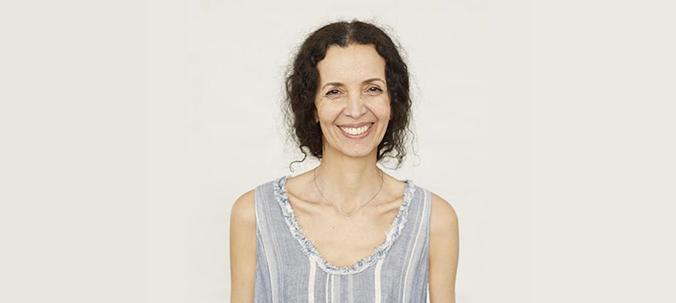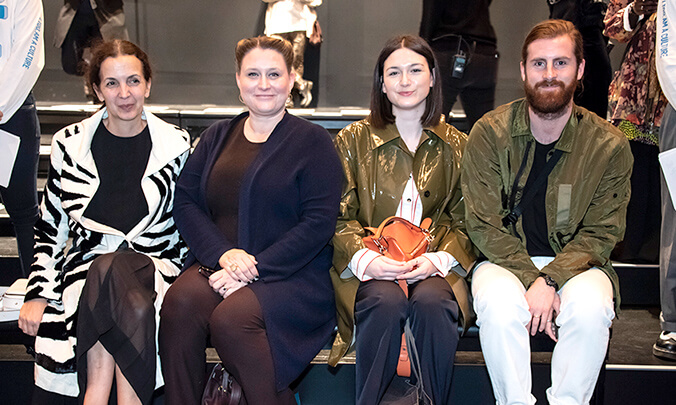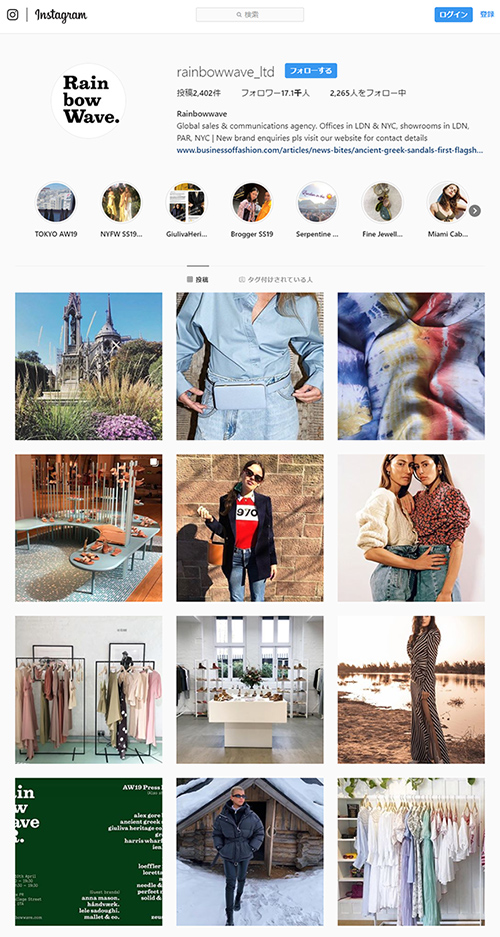Maria Lemos
AmazonFWT 2019 A/W Overseas guest interview, vol.3
Rainbowwave Showroom Owner
[ Website ] http://rainbowwave.com/
[ Instagram ] https://www.instagram.com/Rainbowwave_Ltd/
Based in Paris, Rainbowwave is a company which operates showrooms with press functions. The owner of Rainbowwave, Ms. Maria Lemos, whom is extremely knowledgeable in Japanese culture and brands and also a great Japanophile herself, visited Japan during the Amazon Fashion Week TOKYO 2019 A/W term.
We spoke to Ms. Lemos, whom says is a fan of Japanese brands despite her deep knowledge of overseas markets as a showroom owner, on Rainbowwave, Japanese brands, and fashion week.
We’ve heard you are a big fan of Japan and have been here many times. This time, you came by invitation from JETRO. Do you feel any changes in Tokyo since your last visit?
First, I’d like to express my most sincere gratitude to JETRO for inviting me to Tokyo, one of my favorite cities. I am so happy to be blessed with this opportunity!
This is about my 12th time in Japan. The reason I’ve come to Japan so often was to do buying for my shop in London, called mouki mou, so I used to come here twice a year. It’s been 2 years since my last visit, and I have a strong impression that it has become much more modernized. I also feel an increase in tourists from Asia, and more buying or services geared towards them. While the whole world has become connected and convenient, these are time in which many things are getting lost, so in order to get in touch with those things which identify Japan, such as unchanging traditions, cultures, craftmanship, sthis time I’m hoping to visit regional areas too, such as Naoshima or Okinawa.
Please tell us where you’ve gone to for research during this visit?
I’ve been to Barney’s New York which does business with brands we handle, Nihonbashi Takashimaya, UNITED ARROWS, GARDEN, Waremoko, and a second hand shop called RINKAN. RINKAN carries items sold within 10 years, with maison brands on the 1st floor and only SUPREME on the 2nd floor. The 2nd floor was full of exclusive items, priced higher than the maison brand items on the 1st floor, and young people were buying items priced at 3 times higher than what the items cost at the time they were released on the market. It is an interesting shop in that I got to peak into young people’s view of luxury. My personal favorite is ARTS&SCIENCE, at which both the curation and presentation is superb. I can’t wait to visit their new shop at Daikanyama!
You’ve mentioned this is your 1st time to see Tokyo fashion week. Having actually experienced it, what do you think?
Unlike overseas fashion weeks, it is well organized with smooth service through and through, and I think it is fabulous how the show schedules start on-time. However, there were 2 points which bothered me. First is the absence of big brands which are known overseas, such as ISSEY MIYAKE, COMME des GARCONS, sacai. There seem to be many young, talented brands, but I think, having a balance of big brands and young brands is important in fashion week. The other problem is its timing. I feel, holding the fashion week at this time, after the fashion weeks in Europe and the U.S. have finished and all the buyers are tired out, is not very good timing. And I think it might be better if it doesn’t butt with Seoul fashion week. I have the impression that Tokyo fashion week is stronger in men’s creations, so perhaps after the men’s collection would be better timing. In truth, buyers are cutting their stay short at Paris, Milan, N.Y., London fashion weeks, so in order to have buyers come to Tokyo fashion week, timing is extremely important.
Please tell us, which shows were especially memorable.
My favorite was SHUSHU/TONG. HYKE is very good in showing a business strategical show, and the brand’s message came across clearly. I thought Children of the discordance and ANREALAGE were also very good. And needless to say, KOCHÉ which we handle, was excellent.
From your point of view as a showroom owner, if/when a Japanese brand is planning to advance overseas, what are the strengths and weaknesses of Japanese brands?
The strength of Japanese brands is their creativity and by far the highest quality in the world. Japanese sewing techniques and textiles are truly amazing. For some reason, Japanese people seem to have the image that import textiles are better, and there seem to be brands which are using import fabrics on purpose, but I think both quality and price will be more pleasing if they use Japanese textiles.
On the other hand, the weakness of Japanese brands is price and the fact that the delivery time at which Japanese brands can deliver their products do not match the sales terms of overseas markets.
Could you please introduce Rainbowwave to our readers?
We are a company which supports brands, both as a showroom and in PR. We have 50 staffs in all, and our jewelry department is especially large. We even have a Japanese staff, in charge of Japanese brands, whom used to work for STEADY STUDY.
When deciding on whether to handle a brand or not, above all, I place importance on my first impression of the brands creativity. How the items that a brand offers resonates to my heart is very important. Next is price. No matter how beautiful or wonderful the creation, if the price is not befitting, we find it difficult to handle. Last is MD. The point is, whether a story is completed when the items are laid out, whether the product line-up matches the market. Young designers tend to lack this point of view in their MD. Furthermore, speaking only of young designers and/or brands, I often feel it extremely regrettable that in reality, when advancing into overseas markets, they are still faced with many problems and difficulties, such as lacking capitol and structure for marketing strategy and/or PR, lacking ability to surely complete shipping and/or delivery.
Could you also please tell us the state of the Japanese brands you are presently handling?
Presently, there are 3 Japanese brands we handle, which are OVERCOAT of oomaru seisakusho 2 inc (head-office presently in N.Y.), the jewelry brand SHIHARA, and hum which we have begun to handle this season. OVERCOAT’s sales have doubled, and SHIHARA is gaining a steady line-up of shops carrying their items, including Barney’s N.Y. and Dover Street Market. In the case of jewelry, it is important not to over-develop, so control based on a store roll-out plan is important. Our company operates showrooms in Paris, London and N.Y., and change the way we present brands depending upon each market. Paris is the most important location for a showroom, so we show the most brands there. London is a base for EC businesses, so we offer brands which are fit for on-line sales, such as NET-A-PORTER and MATCHESFASHION. In N.Y., for example denim is strong, and because the U.S. market shows tendencies different from other markets, we edit the brands we show according to their needs, such as showing RE/DONE. Our mission is to increase sales of the brands we handle, so we construct an optimal strategy according to category, brand and market.
To disperse brands into the market, you probably keep a watchful eye on consumer behavior also. Do you feel any changes in the way recent consumers make choices?
It is no longer a society of mass consumption. These are times in which quality is being demanded. In overseas markets, “MADE IN JAPAN” is synonymous with high quality, and during such times as these, this is quite an advantage. All the more reason why, even if usage becomes globally standardized or modernized, Japanese craftsmanship should not, must not be lost. I myself, often gain inspiration from traveling, but of the places I’ve visited lately, Jordan was very interesting. I was extremely moved by their position of happily accepting more refugees than their whole population. There is a jewelry brand we began handling 4 years ago, named PIPPA SMALL. This brand, gathering popularity from many celebrities, including Her Royal Highness, Meghan, Duchess of Sussex, wife of Prince Harry of the Royal family of the United Kingdom, shoulders the task of production by volunteering training to Jordan refugees and giving them jobs. I think, people’s interests in such social meaning or social contribution is on a rise also.
Interview by Tomoko Kawasaki
Translation by Aiko Osaki




